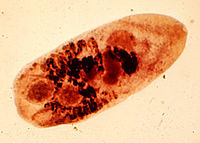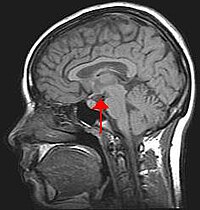
Neuropeptide Y impairs the acquisition of conditioned defeat in Syrian hamsters
Sign Up to like & getrecommendations! Published in 2019 at "Neuroscience Letters"
DOI: 10.1016/j.neulet.2018.09.049
Abstract: Recent evidence indicates that Neuropeptide Y (NPY) may function as a potent anxiolytic as well as a resilience factor that can insulate the brain from the effects of stress. However, most of these studies have… read more here.
Keywords: impairs acquisition; syrian hamsters; conditioned defeat; socially defeated ... See more keywords

Equine herpesvirus type 1 induces both neurological and respiratory disease in Syrian hamsters.
Sign Up to like & getrecommendations! Published in 2017 at "Veterinary microbiology"
DOI: 10.1016/j.vetmic.2017.03.007
Abstract: The equine herpesvirus type 1 (EHV-1) is an important cause of myeloencephalopathy and respiratory disease in horses. Animal models for EHV-1 infection have been specially developed using mice and Syrian hamsters (Mesocricetus auratus). However, few… read more here.
Keywords: respiratory disease; infected hamsters; syrian hamsters; ehv ... See more keywords

Characteristics of liver fibrosis associated with chronic Opisthorchis felineus infection in Syrian hamsters and humans.
Sign Up to like & getrecommendations! Published in 2019 at "Experimental and molecular pathology"
DOI: 10.1016/j.yexmp.2019.104274
Abstract: The food-borne liver trematode Opisthorchis felineus causes severe liver damage, including fibrosis. This study shows a comparison of the characteristics between cholangiofibrosis and periductal fibrosis in infected people and in the golden hamster as an… read more here.
Keywords: opisthorchis felineus; infection; syrian hamsters; felineus infection ... See more keywords

Temporal omics analysis in Syrian hamsters unravel cellular effector responses to moderate COVID-19
Sign Up to like & getrecommendations! Published in 2021 at "Nature Communications"
DOI: 10.1038/s41467-021-25030-7
Abstract: In COVID-19, immune responses are key in determining disease severity. However, cellular mechanisms at the onset of inflammatory lung injury in SARS-CoV-2 infection, particularly involving endothelial cells, remain ill-defined. Using Syrian hamsters as a model… read more here.
Keywords: analysis; infection; moderate covid; syrian hamsters ... See more keywords

MVA vector expression of SARS-CoV-2 spike protein and protection of adult Syrian hamsters against SARS-CoV-2 challenge
Sign Up to like & getrecommendations! Published in 2021 at "npj Vaccines"
DOI: 10.1038/s41541-021-00410-8
Abstract: Numerous vaccine candidates against SARS-CoV-2, the causative agent of the COVID-19 pandemic, are under development. The majority of vaccine candidates to date are designed to induce immune responses against the viral spike (S) protein, although… read more here.
Keywords: sars cov; mva; adult syrian; syrian hamsters ... See more keywords

CRISPR-Cas9 editing of the arginine–vasopressin V1a receptor produces paradoxical changes in social behavior in Syrian hamsters
Sign Up to like & getrecommendations! Published in 2022 at "Proceedings of the National Academy of Sciences of the United States of America"
DOI: 10.1073/pnas.2121037119
Abstract: Significance Arginine–vasopressin (AVP) acting on V1a receptors (Avpr1as) represents a key signaling mechanism in a brain circuit that increases the expression of social communication and aggression. We produced Syrian hamsters that completely lack Avpr1as (Avpr1a… read more here.
Keywords: crispr cas9; v1a; arginine vasopressin; receptor ... See more keywords

duper is a null mutation of Cryptochrome 1 in Syrian hamsters
Sign Up to like & getrecommendations! Published in 2022 at "Proceedings of the National Academy of Sciences of the United States of America"
DOI: 10.1073/pnas.2123560119
Abstract: Significance We successfully identified the duper allele as a null mutation of Cryptochrome 1 in Syrian hamsters. Here, we have shown the use of fast homozygosity mapping as an effective approach to identify causal mutations… read more here.
Keywords: cryptochrome syrian; mutation cryptochrome; null mutation; syrian hamsters ... See more keywords

The Preoptic Area and the RFamide-Related Peptide Neuronal System Gate Seasonal Changes in Chemosensory Processing.
Sign Up to like & getrecommendations! Published in 2017 at "Integrative and comparative biology"
DOI: 10.1093/icb/icx099
Abstract: Males of many species rely on chemosensory information for social communication. In male Syrian hamsters (Mesocricetus auratus), as in many species, female chemosignals potently stimulate sexual behavior and a concurrent, rapid increase in circulating luteinizing… read more here.
Keywords: preoptic area; system; neuronal system; syrian hamsters ... See more keywords

SARS-CoV-2 Variant Pathogenesis Following Primary Infection and Reinfection in Syrian Hamsters
Sign Up to like & getrecommendations! Published in 2023 at "mBio"
DOI: 10.1128/mbio.00078-23
Abstract: With the continued circulation and emergence of new severe acute respiratory syndrome coronavirus 2 (SARS-CoV-2) variants, understanding differences in the effects between the initial infection and a subsequent reinfection on disease pathogenesis is critical and… read more here.
Keywords: infection; pathology; sars cov; reinfection ... See more keywords

Mucociliary transport deficiency and disease progression in Syrian hamsters with SARS-CoV-2 infection
Sign Up to like & getrecommendations! Published in 2023 at "JCI Insight"
DOI: 10.1172/jci.insight.163962
Abstract: Substantial clinical evidence supports the notion that ciliary function in the airways is important in COVID-19 pathogenesis. Although ciliary damage has been observed in both in vitro and in vivo models, the extent or nature… read more here.
Keywords: mucociliary transport; infection; sars cov; disease progression ... See more keywords

Cellular tropism of SARS-CoV-2 in the respiratory tract of Syrian hamsters and B6.Cg-Tg(K18-ACE2)2Prlmn/J transgenic mice.
Sign Up to like & getrecommendations! Published in 2021 at "Veterinary pathology"
DOI: 10.1177/03009858211043084
Abstract: Several animal models have been developed to study the pathophysiology of SARS-CoV-2 infection and to evaluate vaccines and therapeutic agents for this emerging disease. Similar to infection with SARS-CoV-1, infection of Syrian hamsters with SARS-CoV-2… read more here.
Keywords: infection; syrian hamsters; transgenic mice; sars cov ... See more keywords